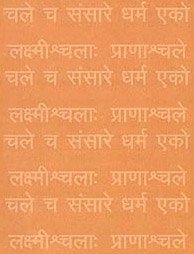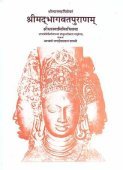Yadava, Yādava: 21 definitions
Introduction:
Yadava means something in Hinduism, Sanskrit, the history of ancient India, Marathi. If you want to know the exact meaning, history, etymology or English translation of this term then check out the descriptions on this page. Add your comment or reference to a book if you want to contribute to this summary article.
In Hinduism
Purana and Itihasa (epic history)
Source: archive.org: Puranic EncyclopediaYādava (यादव).—See under Yaduvaṃśa.
Source: Cologne Digital Sanskrit Dictionaries: The Purana Index1a) Yādava (यादव).—A name of Kṛṣṇa.*
- * Vāyu-purāṇa 96. 40; Brahmāṇḍa-purāṇa III. 71. 41.
1b) Descendants of Yadu also called Mādhavas and Vṛṣṇis; a tribe who had Kṛṣṇa and Balarāma as their lords;1 the maternal uncle line of Sagara with capital at Mathurā; Kakudmin was their king for some time;2 inhabitants of Dvāravatī; three crores strong; formerly Asuras who were killed in the Devāsura wars, and were born as men; of them 600,000 were warriors; eleven kulas or clans distinguished among them; all Vaiṣṇavas.3
- 1) Bhāgavata-purāṇa IX. 23. 30; X. 67. 25; XI. 30. 11; Brahmāṇḍa-purāṇa III. 71. 216; Matsya-purāṇa 271. 2.
- 2) Brahmāṇḍa-purāṇa III. 49. 6; 61. 22.
- 3) Vāyu-purāṇa 86. 27; 96. 215 and 252-5.
1c) The family of Yadu;1 unlimited in numbers; had 38 millions of teachers of army;2 consisted of 101 families over whom Viṣṇu was ruler and teacher;3 consisted of Kukuras, Vṛṣṇis and Andhakas;4 to deprive them of all their possessions was the plan of Kaṃsa;5 on Kṛṣṇa's advice and in fulfilment of the curse of sages to die of the iron club born to Sāmba, left Dvārakā for Prabhāsa; having drunk they attacked one another and finally took hold of rushes grown out of the iron pieces of musala and killed themselves.6
- 1) Viṣṇu-purāṇa IV. 11. 30.
- 2) Ib. IV. 15. 45-6.
- 3) Ib. IV. 15. 48-9.
- 4) Ib. V. 35. 16; 37. 39.
- 5) Ib. V. 15. 20.
- 6) Ib. V. 37. 38-47.
Yādava (यादव) is a name mentioned in the Mahābhārata (cf. I.70.2) and represents one of the many proper names used for people and places. Note: The Mahābhārata (mentioning Yādava) is a Sanskrit epic poem consisting of 100,000 ślokas (metrical verses) and is over 2000 years old.

The Purana (पुराण, purāṇas) refers to Sanskrit literature preserving ancient India’s vast cultural history, including historical legends, religious ceremonies, various arts and sciences. The eighteen mahapuranas total over 400,000 shlokas (metrical couplets) and date to at least several centuries BCE.
Vaishnavism (Vaishava dharma)
Source: Pure Bhakti: Bhagavad-gita (4th edition)Yādava (यादव) refers to “śrī Kṛṣṇa, the best of the Yādu dynasty”. (cf. Glossary page from Śrīmad-Bhagavad-Gītā).

Vaishnava (वैष्णव, vaiṣṇava) or vaishnavism (vaiṣṇavism) represents a tradition of Hinduism worshipping Vishnu as the supreme Lord. Similar to the Shaktism and Shaivism traditions, Vaishnavism also developed as an individual movement, famous for its exposition of the dashavatara (‘ten avatars of Vishnu’).
Vedanta (school of philosophy)
Source: Shodhganga: Siva Gita A Critical StudyYādava (यादव) or Yādavagītā refers to one of the sixty-four Gītās commonly referred to in Hindu scriptures.—Gītā is the name given to certain sacred writings in verse (often in the form of a dialogue) which are devoted to the exposition of particular religious and theosophical doctrines. Most of these Gītās [i.e., Yādava-gītā] originate from the Mahābhārata or the various Purāṇas.

Vedanta (वेदान्त, vedānta) refers to a school of orthodox Hindu philosophy (astika), drawing its subject-matter from the Upanishads. There are a number of sub-schools of Vedanta, however all of them expound on the basic teaching of the ultimate reality (brahman) and liberation (moksha) of the individual soul (atman).
General definition (in Hinduism)
Source: WikiPedia: HinduismThe Yadavas (lit: 'descended from Yadu') were an ancient Indian people who believed themselves to be descended from Yadu, a mythical king. They are listed in ancient Indian literature as the segments of the lineage of Yadu (Yaduvamsha).
India history and geography
Source: Wikipedia: India HistoryYādava (यादव).—The Yādavas were an ancient Indian people who believed themselves to be descended from Yadu, a mythical king. The community was probably formed of four clans, being the Ābhīra, Andhaka, Vṛṣṇi, and Sātvatas, who all worshipped Kṛṣṇa. They are listed in ancient Indian literature as the segments of the lineage of Yadu (Yaduvaṃśa).
Source: Shodhganga: Kakati Ganapatideva and his timesYādava is one of the ancient dynasties from India (Āndhradeśa or Andhra Pradesh), conquered and subjugated by Gaṇapatideva (r. 1199-1262 A.D.) who let them rule their territory as an independent māṇḍalika.—Three branches of the Yādava dynasty ruled over small tracts of Āndhradeśa with Addanki, Pānagal and Ālavulapāḍu as their headquarters. They were probably branches of the Yādavas of Devagiri and of Marāṭha origin.
Yādavas of Addanki:—The chiefs were also known as Cakranārāyaṇas and this was prefixed to their names who ruled parts of Prakasam District from Addanki as head quarters. They claimed Śālaṅkāyana-gotra. Sāraṅgadhara I (A.D. 1150) was the earliest known member of this dynasty and was contemporary of Kākati Rudradeva.
Source: Shodhganga: Elements of Art and Architecture in the Trtiyakhanda of the Visnudharmottarapurana (history)Yadava refers to a certain period in the history of Indian Art.—The chronological order of the development of Indian Art as stated in The Heritage of Indian Art is as follows—[...] 13. Hoyaśala and Yādava dynasties of Karnataka belong to the period from 1111A.D to 1318 A.D. These two dynasties comprise the Architecture of temples of Halebeedu and Belur.

The history of India traces the identification of countries, villages, towns and other regions of India, as well as mythology, zoology, royal dynasties, rulers, tribes, local festivities and traditions and regional languages. Ancient India enjoyed religious freedom and encourages the path of Dharma, a concept common to Buddhism, Hinduism, and Jainism.
Languages of India and abroad
Marathi-English dictionary
Source: DDSA: The Molesworth Marathi and English Dictionaryyādava (यादव).—m (S) The patronymic of the descendents of yadu an ancient king of India.
Marathi is an Indo-European language having over 70 million native speakers people in (predominantly) Maharashtra India. Marathi, like many other Indo-Aryan languages, evolved from early forms of Prakrit, which itself is a subset of Sanskrit, one of the most ancient languages of the world.
Sanskrit dictionary
Source: DDSA: The practical Sanskrit-English dictionaryYādava (यादव).—[yadorapatyam aṇ] A descendant of Yadu.
2) Name of Kṛṣṇa.
-vī 1 Name of Durgā
2) Of Kuntī; भद्रं ते यादवीमातर्वचश्चेदं निबोध मे (bhadraṃ te yādavīmātarvacaścedaṃ nibodha me) Mahābhārata (Bombay) 15.3.3.
3) Of Subhadrā; कर्णं द्रक्षति कुन्ती च सौभद्रं चापि यादवी (karṇaṃ drakṣati kuntī ca saubhadraṃ cāpi yādavī) Mahābhārata (Bombay) 15.31.2.
-vam A stock of cattle.
Derivable forms: yādavaḥ (यादवः).
Source: Cologne Digital Sanskrit Dictionaries: Shabda-Sagara Sanskrit-English DictionaryYādava (यादव).—m.
(-vaḥ) 1. Krishna, as descended from the family of Yadu. 2. A Yadava, or descendant of Yadu. f. (-vī) A name of Durga. n.
(-vaṃ) Stock of cattle. E. yadu a proper name, aṇ aff. of descent, &c.
Source: Cologne Digital Sanskrit Dictionaries: Benfey Sanskrit-English DictionaryYādava (यादव).—i. e. yadu + a, I. m. 1. A Yādava, or descendant of Yadu. 2. Kṛṣṇa. Ii. f. vī, Durgā. Iii. n. A stock of cattle.
Source: Cologne Digital Sanskrit Dictionaries: Cappeller Sanskrit-English DictionaryYādava (यादव).—[feminine] ī relating to Yadu; [masculine] & [feminine] his descendant, [masculine] [plural] his race.
Source: Cologne Digital Sanskrit Dictionaries: Aufrecht Catalogus CatalogorumYādava (यादव) as mentioned in Aufrecht’s Catalogus Catalogorum:—lexicographer. See Yādavaprakāśa.
Source: Cologne Digital Sanskrit Dictionaries: Monier-Williams Sanskrit-English Dictionary1) Yādava (यादव):—mf(ī)n. ([from] yadu) relating to or descended from Yadu, [Mahābhārata; Kāvya literature] etc.
2) m. a descendant of Y° (also [plural]), [ib.]
3) Name of Kṛṣṇa, [cf. Lexicographers, esp. such as amarasiṃha, halāyudha, hemacandra, etc.]
4) Name of various authors (cf. [compound]), [Catalogue(s)]
5) n. a stock of cattle, [cf. Lexicographers, esp. such as amarasiṃha, halāyudha, hemacandra, etc.]
Source: Cologne Digital Sanskrit Dictionaries: Yates Sanskrit-English DictionaryYādava (यादव):—(vaḥ) 1. m. Krishna as descended from the family of Yadu. f. (vī) Durgā. n. Stock of cattle.
Source: DDSA: Paia-sadda-mahannavo; a comprehensive Prakrit Hindi dictionary (S)Yādava (यादव) in the Sanskrit language is related to the Prakrit word: Jāyava.
[Sanskrit to German]
Sanskrit, also spelled संस्कृतम् (saṃskṛtam), is an ancient language of India commonly seen as the grandmother of the Indo-European language family (even English!). Closely allied with Prakrit and Pali, Sanskrit is more exhaustive in both grammar and terms and has the most extensive collection of literature in the world, greatly surpassing its sister-languages Greek and Latin.
Kannada-English dictionary
Source: Alar: Kannada-English corpusYādava (ಯಾದವ):—[adjective] relating to the family of Yadu (which Křṣṇa belonged to).
--- OR ---
Yādava (ಯಾದವ):—
1) [noun] a man belonging to the family of Yadu.
2) [noun] Křṣṇa, who belonged to this family.
3) [noun] a man belonging to the Hoysaḷa family that ruled some parts of Karnāṭaka.
Kannada is a Dravidian language (as opposed to the Indo-European language family) mainly spoken in the southwestern region of India.
See also (Relevant definitions)
Starts with (+16): Yadava cakravartin, Yadava pandita, Yadava suri, Yadava vajapeyin, Yadava vidyabhushana, Yadava-cakravartin, Yadavabhyudaya, Yadavacampu, Yadavacarya, Yadavadhi, Yadavagiri, Yadavagirimahatmya, Yadavagita, Yadavajadavari, Yadavajadavarya, Yadavajadavaryas, Yadavaka, Yadavakalaha, Yadavakosha, Yadavakuta.
Ends with: Abhikhyayadava, Dayadava, Niryadava.
Full-text (+286): Niryadava, Satyaki, Satvat, Yadavodaya, Vikadru, Uddhava, Anadhrishti, Shyala, Yadavavyasa, Yadavabhyudaya, Hridika, Yadavi, Dasharha, Yadu, Yatavar, Shini, Yadavanvaya, Devamidha, Yadavakosha, Bhoja.
Relevant text
Search found 73 books and stories containing Yadava, Yādava; (plurals include: Yadavas, Yādavas). You can also click to the full overview containing English textual excerpts. Below are direct links for the most relevant articles:
The history of Andhra country (1000 AD - 1500 AD) (by Yashoda Devi)
Part 1 - The Yadavas of Addanki (A.D. 1150-1270) < [Chapter XIV - The Yadavas]
Introduction (Yadava dynasty) < [Chapter XIV - The Yadavas]
Part 12 - End of the Panugal Yadva dynasty < [Chapter XIV - The Yadavas]
The End of the Yadavas < [Fifth Section]
Kalayavana < [Fifth Section]
The Jewel Syamantaka < [Fourth Section]
Garga Samhita (English) (by Danavir Goswami)
Verse 5.14.9 < [Chapter 14 - The Meeting of King Nanda and Uddhava]
Verse 5.4.36 < [Chapter 4 - The Journey to Śrī Mathurā]
Verse 5.9.6 < [Chapter 9 - The Happiness of the Yadus]
An Aspect of Sri Krishna, the General < [October-December 1942]
Book Reviews < [April – June, 2000]
Who’s Who < [October – December, 2004]
Puranic encyclopaedia (by Vettam Mani)
Harivamsha Purana (by Manmatha Nath Dutt)
Chapter 47 - Rukshmini’s Swayamvara < [Book 2 - Vishnu Parva]
Chapter 37 - An Account of Haryashva < [Book 2 - Vishnu Parva]
Chapter 23 - Andhaka’s Advice to Kamsa < [Book 2 - Vishnu Parva]
Related products
